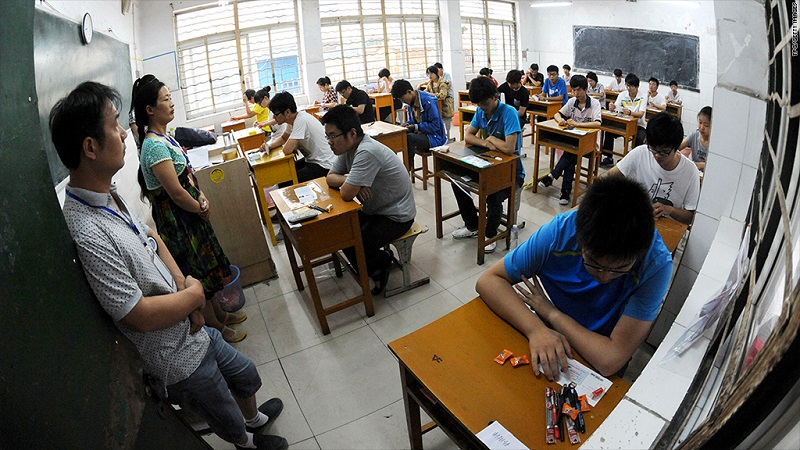An estimated three percent of Chinese foreign exchange students enrolled at US schools – or about 8,000 – were dismissed from their studies last year, mostly because they were performing so poorly.
The analysis was made in the White Paper on Dismissal Issues of Chinese Students in the United States 2015, recently released by WholeRen Education, a US-based agency providing services to Chinese students. The white paper analyzed a sample of 1,657 Chinese students who were dismissed by schools at all levels in the US from 2013 to 2015.
More than 57 percent of students dismissed were due to low grade scores. Sixty-one percent of undergraduates dismissed had a GPA lower than 2.0, while 72 percent of post-graduates scored lower than 3.0.
The white paper says an improper learning attitude, mental and physical problems were all factors that contributed to poor academic performance. Andrew H. Chen, chief development officer of WholeRen Education, also cited the students’ inability to adjust to the learning environment in the US as well as their insufficient learning ability.
“Everything about the US education, from the curriculum system to the teaching approaches and question types in exams, is so different from China. It takes a lot of time and effort for students to adjust themselves to that, and some who can’t get used to it may fail,” Chen said.
Maybe most surprising (or not, depending on your views) is that academic dishonesty and plagiarism was the second-largest reason for the expulsion of Chinese foreign exchange students in the US, making up 23 percent of the sample group.
The figures were released as more and more Chinese students are heading to the US to further their educations. There were 274,439 Chinese students studying in the US during the 2013-14 academic year, up 16.5 percent from the year before. That year, China was responsible for more than one in four foreign students on U.S. campuses, more than any other country. Experts explain the rise in Chinese exchange students on the growing Chinese middle class. “There are a lot of Chinese entrepreneurs, businessmen of all sorts business leaders, who are simply wealthier today, and they can afford to send their sons and daughters abroad,” said Rand Corporation economist Jim Hosek.
But with so many Chinese exchange students also comes concerns over fraudulent applications. 1 in 10 applications to U.S. colleges by Chinese students may include fraudulent material, including phony essays and high-school transcripts.Admission officers say as many as one in 10 applications to U.S. colleges by Chinese students may include fraudulent material, including phony essays and high-school transcripts.
US educational consulting firm Zinch China says admissions offices across the USA reported that 90 percent of the Chinese recommendation letters that they received had been falsified in 2011. As well, 70 percent of the admissions essays were apparently written by somebody other than the applicant. Futhermore, 50 percent of transcripts had been changed.
“There are a lot of Chinese students and parents trying to get into the best quality schools they can,” said Eddie West, director of international initiatives for the National Association for College Admission Counseling. “Obviously there’s competition and incentives to cut corners.”
While US schools reap huge economic rewards from welcoming Chinese foreign exchange students, not everyone is happy about it. In February, a private company withdrew a proposal to place 30 Chinese students in an Indiana high school after local residents objected. Christopher Pupillo, one of the parents who opposed the plan, cited a “continued lack of transparency and unwillingness to engage honestly and openly with the community.”
The massive influx of Chinese students has also prompted comparisons between education systems in the USA and China, especially with the news that Shanghainese high school students vastly outscored their American counterparts on an international standardized test called the PISA.
Experts were quick to point out this did not necessarily mean that US students are falling behind their Chinese peers, but that the latter are simply better at taking tests.
“The entire system is geared toward that one goal — taking [a] test,” said Yasheng Huang, a professor at the Massachusetts Institute of Technology, who added, “In terms of imaginative talking, coming up with good ideas, taking risks, those are actually very weak.”
Although China itself is becoming an education provider to foreign students, recently vaulting over France to become the third-most popular country in the world for international students, it can’t claim to be attracting American students the way that the USA has been with Chinese students. While universities in China are popular among students from under-developed Asian and African nations, schools of the USA are known for much more.
Peggy Blumenthal, executive vice president of the Institute of International Education, believes the possibility for a better educational experience in the USA lures students away from the Chinese education system.
“If you are spending all your time drilling what the answers are for your test, does that prepare you for the kind of innovative self-reliant, challenge-the-status-quo kind of thinking that is rewarded at the college level in the United States?” asked Blumenthal.
Related:

